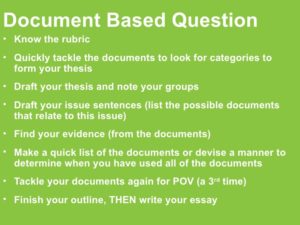A Brief Overview of the Document-Based Essay
The purpose of writing a document-based essay is for you to study the document(s) provided by your professor to discover and communicate a significant point about history. This type of writing parallels the writing in professional, scholarly history books: the writing is thesis-driven and evidence-based. It seeks to prove a point.
The document-based essay is like other academic writing in history in that it shows how the topic under discussion relates to the time period of your focus. You should, therefore, keep your focus on the documents’ historical context (rather than on contemporary America) and seek to answer this question: Why did this topic matter to people at that time?
Audience
Your primary audience is your professor and perhaps your classmates. However, you should write with an academic audience in mind that is knowledgeable about history, but not necessarily a specialist in the documents you are analyzing.
Writing Process Tips
Read the entire assignment sheet carefully! If the assignment asks you a question relating to one or more documents, do the following before beginning to write:
- Read the assigned document(s) carefully. Get a sense of what each document says, and what their purpose and audience seem to be.
- Read the question on the assignment sheet carefully. Get a clear sense of what your professor wants you to do with the document(s).
- Re-read the document(s) in light of the assignment sheet. If your task is to write about more than one document, concentrate on how the assignment guides you to think about the relationship among the documents.
- Try creating a compare/contrast chart before crafting a thesis, if you are writing about multiple documents. On a piece of paper, draw a column for each document. Describe each document in its own column, then take stock of how the documents compare. Such a chart can help you to produce a thesis that deals directly with the contents of the documents rather than your assumptions about the documents.
Keep in mind that your answer to the assignment’s question is your thesis. It usually appears in the first paragraph of the essay. Be sure to include all points that you will make in your paper in your first paragraph. A reader should be able to outline the rest of your paper just from the thesis. It can be helpful (or even necessary) to outline in order to get things in chronological order, as doing so will help you to prevent errors in argument. Most importantly, one idea should flow from another with smooth transitions of thought.
You can insert into your outline the various pieces of evidence needed to support your thesis.
- Evidence comes from the documents and should be used to support your argument. Analysis of how the documents support your argument is essential.
- Explain the context of your evidence: From what document does it come? Who is speaking/writing? Does the writer exhibit bias? Etc. Inform your reader what he or she might need to know in order to properly interpret this material in the context of your argument.
- Avoid lengthy description or summary of documents. It is better to find a quote that illustrates the point that you want to make. Be sure to explain why or how the quote supports your argument.
Edit and proofread carefully. How credible is an argument made within a paper riddled with grammatical/mechanical errors? Edit beyond relying on spell check–computers just aren’t as capable as the human mind.
Document-Based Essay Organization
Introduction: Setting and Thesis
Your paper should begin by describing the historical context of your topic: Where is the topic in space and time? Who are the main players? Set up the context at the beginning so readers will care about the information presented throughout the rest of the paper. The introduction is where your thesis–an argument–should appear.
Body Paragraphs
Each body paragraph should include a topic or summary sentence and appropriate transitions between paragraphs. Throughout the body of the paper, be sure to give enough context to introduce each source you discuss, and thoroughly address the documents you have been assigned.
Conclusion
A conclusion should:
- Summarize what was proven in the paper as well as the connections the writer made.
- Explain why this matters: what did people of that historical time learn from this?
- Satisfy the introduction. Consider these questions: Do my introduction and conclusion tie together? Do I have to add to/subtract from my introduction to make my paper a more coherent whole? A conclusion should not: Simply summarize the paper. Ask further questions that will be left unaddressed. Make vague comments about how the issues applies to today’s world; rather, the conclusion should focus on what the writer is coming to think about in relation to the issue he/she addresses.
Tips for Writing in the Style of a Historian
History writers should address their insights rather than their feelings. The paper’s purpose is to prove an argument–and this is achieved through evidence and analysis in historical writing, not through emotional venting. Show your intuitive thoughts/critical thinking insights without spending time expressing your emotions.
Take Notice of Voice/Tone
Write in a formal, academic voice:
- Avoid passive voice as much as possible. Phrases like “it was done” don’t explain who did what, and why. For more help identifying passive voice–and advice in recasting.
- Use “I” sparingly, and only when referencing your own ideas. Readers will assume the paper is your argument; you don’t need to write “I think” or “I believe” repeatedly.
- Avoid “you,” as it is not formal enough–and it can be somewhat confusing. Who is “you”? The reader? The people in the historical period of which you’re writing? Americans today?
Format And Cite Appropriately
Use Chicago Style for document formatting and in citing sources–typically footnotes, reference page, cover page, etc. Your professor’s assignment sheet should indicate any additional formatting or citation preferences.
Give context when incorporating research. From what document does the information come? Who is speaking/writing? Does the writer exhibit bias? What makes the source reputable? How is the quotation related to your paragraph?
Avoid piling sources into a given paragraph; usually it is better to address no more than two pieces of evidence in a given paragraph. Use sources to support your ideas/arguments.
Wikipedia and other web-based or print encyclopedias are not good evidence. Wikipedia is a great tool for learning the basics of a time period, event, or historical figure, and the entry on a topic might link to useful research. However, Wikipedia is essentially an encyclopedia–not the kind of source historians use to support their arguments.
Prompts for Writing Consultations
- What is the paper’s thesis? Does the thesis fully answer the question being posed? Could the thesis be cleared up/more concise/more interesting?
- Does the introduction set up the historical context of the situation? Does the writer provide sufficient primary and secondary evidence?
- Starting with the thesis, outline the paper’s argument. Does the argument or the paper fit the outlined points or is revision needed? Do the introduction and conclusion agree or has the argument evolved or changed during the paper? If there are differences, the paper should be revised to offer a consistent argument.
- Does the argument miss something it should cover, or mention anything that isn’t necessary or beneficial? Does the argument anticipate and refute counterarguments?
- Does the writer put forward too many biased views/emotional responses to evidence-based declarations?
- Is chronology apparent throughout the paper?
- Are the introduction and conclusion effectively written?
- Do the ideas and arguments smoothly transition from one to another throughout the paper? If not, how could those arguments be tied together more clearly and link back to the overall argument?

